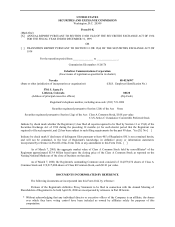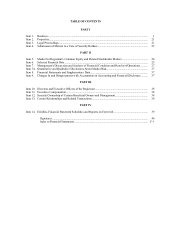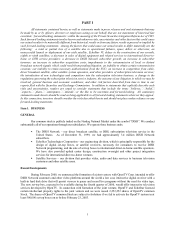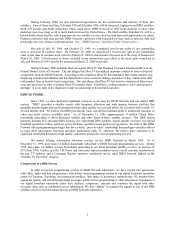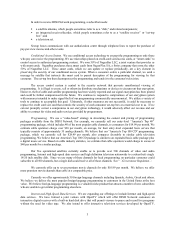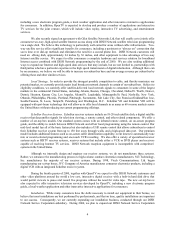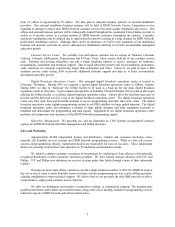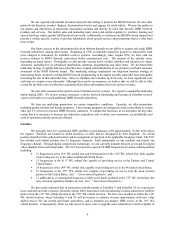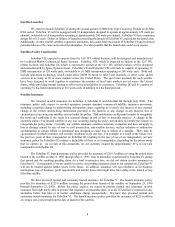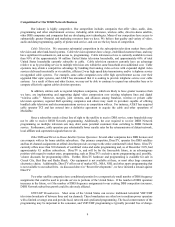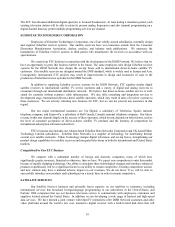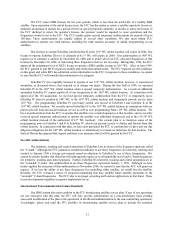Dish Network 1999 Annual Report Download - page 4
Download and view the complete annual report
Please find page 4 of the 1999 Dish Network annual report below. You can navigate through the pages in the report by either clicking on the pages listed below, or by using the keyword search tool below to find specific information within the annual report.2
During February 2000, we also announced agreements for the construction and delivery of three new
satellites. Two of these satellites, EchoStar VII and EchoStar VIII, will be advanced, high-powered DBS satellites.
Both will include spot-beam technology which could allow DISH Network to offer local channels or other value
added services in as many as 60 or more markets across the United States. The third satellite, EchoStar IX, will be a
hybrid Ku/Ka-band satellite, which may provide our satellite services division with increased opportunities to attract
business customers and may provide DISH Network customers with expanded services such as Internet, data and
potentially two-way wireless communications. See “-DISH Network - Satellites Under Construction.”
On each of July 19, 1999, and October 25, 1999, we completed two-for-one splits of our outstanding
class A and class B common stock. On February 28, 2000 we announced a two-for-one split of our outstanding
class A and class B common stock effective March 22, 2000 to shareholders of record as of the close of business on
March 10, 2000. All references to shares included herein retroactively give effect to the stock splits completed in
July and October of 1999, but not the announced March 22, 2000 stock split.
During February 2000 EchoStar filed suit against DirecTV and Thomson Consumer Electronics/RCA in the
Federal District Court of Colorado. The suit alleges that DirecTV has utilized improper conduct in order to fend off
competition from the DISH Network. According to the complaint, DirecTV has demanded that certain retailers stop
displaying EchoStar merchandise and has threatened to cause economic damage to retailers if they continued to offer
both product lines in head-to-head competition. The suit alleges that DirecTV has acted in violation of federal and
state anti-trust laws in order to protect DirecTV’s market share. EchoStar is seeking injunctive relief and monetary
damages. It is too early in the litigation to make an assessment of the probable outcome.
DISH NETWORK
Since 1994, we have dedicated significant resources to develop the DISH Network and our related DBS
system. “DBS” describes a satellite service with frequency allocation and wide spacing between satellites that
generally permits higher powered transmissions than other satellite services and allows for reception with a small, 18-
24 inch satellite dish. We believe that DBS provides the most cost-efficient national point to multi-point transport of
video and audio services available today. As of December 31, 1999, approximately 13 million United States
households subscribed to direct broadcast satellite and other direct-to-home satellite services. Our DBS system
presently includes FCC-allocated DBS licenses, five operational DBS satellites, digital satellite receivers, two digital
broadcast operations centers, customer service facilities, and other assets used in our operations. We believe that DISH
Network offers programming packages that have a better “price-to-value” relationship than packages currently offered
by most other subscription television providers, particularly cable TV operators. We believe there continues to be
significant unsatisfied demand for high quality, reasonably priced television programming services.
We started offering subscription television services on the DISH Network in March 1996. As of
December 31, 1999, more than 3.4 million households subscribed to DISH Network programming services. During
1999, more than 1.4 million net new households subscribed to our direct broadcast satellite services, an increase of
63% from 1998. Further, in 1999, J.D. Power and Associates ranked us number one in overall customer satisfaction in
the pay TV industry and a Consumer Reports customer satisfaction survey rated DISH Network highest in the
“Satellite TV Providers” category.
Components of a DBS System
In order to provide programming services to DISH Network subscribers, we have entered into agreements
with video, audio and data programmers, who deliver their programming content to our digital broadcast operations
center in Cheyenne, Wyoming, via commercial satellites, fiber optics or microwave transmissions. We monitor those
signals for quality, and can add promotional messages, public service programming or other information. Equipment at
our digital broadcast operations center then digitizes, compresses, encrypts and combines the signal with other
necessary data, such as conditional access information. We then “uplink” or transmit the signals to one of our DBS
satellites where we then broadcast directly to DISH Network subscribers.

